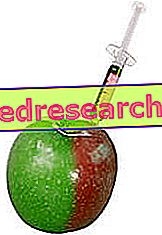Guidelines for a correct start to the sporting practice in the developmental age
Evolutionary age: age range from 11 to 16 years.
In these years it is necessary to become positive elements in the promotion process, capable of giving birth and sustaining motivation in the boy and not just being cold executors of rigid and standardized motor schemes.
Modern programming
The exercise itself does not make sense if it is not inserted in a programmed context. The programming (organization of educational moments) is characterized by having shifted attention from the contents to the subjects of the educational action, the people
Purpose (goals)



Linking the practical part to the theoretical part makes the learning of the latter more motivating because it relates to situations just experienced. It is important to verify in the long, medium and short term both the realization and the efficacy of the objectives and the forced choices and the motivation of the subjects (to promote the rational exchange of ideas with the person avoiding the PIGMALIONE effect)
The method of working with interest groups (of individualisation)
This method is based on the principle of satisfying the needs of the individual by the group.
In this regard, the session is organized so as to satisfy the needs of each subject by integrating them into a common context (the group). Many adolescents abandon physical activity precisely because they are too standardized and too deductive
Objectives of school physical education
Education must first and foremost be a means of development of the person that takes into account the real needs of the population but also of the individual (eg using working methods in interest groups). It should therefore not only concern physical development, but also social and motivational psychological development.
Inserting everything in a general context of starting the motor practice as a means of prevention, motivation, participation and social development.
WORKING METHODS THAT ENCOURAGE MOTIVATION
Motivation is the main result of satisfying one's needs.
Thanks to an appropriate choice of:
Working methods (group work-individualization) (inductive-deductive)
principles of work (multilateralism, versatility, multi-sport)
Activities
It is possible to meet the needs of every single boy.
Choice of appropriate content
Check the relationship between content and objectives, take care of the motivational aspects, then the needs of the subjects.
To increase the effectiveness of work, it is necessary to keep in mind the adequacy and harmony with the method, the significance and the possibility of realization (spaces, materials, seasonal alternation).
| Inductive method | Deductive method |
| of the resolution of tasks | Prescriptive-deductive |
| Of the guided discovery | Mixed method |
| Free exploration | Method of assigning tasks |
| Experimentation-observation-comparison-abstraction-generalization | Explanation proof proofing execution |
| The student student is the protagonist of the learning teaching process | The trainer teacher is the protagonist of the learning teaching process |
| Educate = bring out | Educate = Put inside |
| Student attitude is active | "" is passive |
| NB very adherent to the principle of polyvalence: good involvement as well as emotional-social-cognitive motor | Not adherent to the principle of versatility |
The organization of a multi-purpose, multilateral and multi-sports program
- principle of versatility: motor activities must be oriented towards the development of skills and abilities whose transferability, value and validity are manifold
- principle of multerality: refers to the didactic aspects, that is to the contents, the means and their organization (games, routes, circuits, multiple tests)
- principle of polisportività: refers to the practice of multiple and varied sports disciplines or game actions taken from them
A program of physical activity "unilateral and standardized" has as its main objective to train and develop the physical quality most involved in that particular sport. To this end, training programs are adopted that use few and repetitive gestures, with the almost inevitable risk, of slowing down or even worse, blocking the child's motor learning processes.
On the contrary, a "multilateral" training favors the parallel and contemporary development of the psychophysical qualities that can be trained in the young person as he uses various alternate and multi-purpose exercises.
Therefore the multilateral nature of the training process must be the guiding principle of youth training.
The factors of good health in the lesson
- Strength and firmness of the abdominal wall muscles
- Flexibility of the sacral loin tract and limbs
- Body composition as a ratio between lean mass and adipose tissue
- Cardio-vascular and respiratory efficiency
The organization of the lesson
- Warm-up (increase in body temperature, acceleration of the respiratory rhythm, stress of the CNS and SNP)
- The central part characterizing the pre-established objectives (sports practice, technical tactical actions in groups derived from sports games, development of conditional skills through specific exercises
- The development of good health factors
- The cool-down (restoration of muscular, circulatory, respiratory and psychological conditions more suited to the activities to be performed later
Coordinative skills
The coordination skills are divided into:
- GENERAL: motor learning skills, leadership and control skills, ability to adapt and transform movement
- SPECIAL: spatio-temporal perception, balance, combination, differentiation, reaction, anticipation, motor fantasy, rhythmization
- PSYCHOMOTORIES: spatio-temporal structuring, manual ocular coordination and podular oculus, lateralization, respiratory education and control, control of muscle tone and psychomotor relaxation, general dynamic coordination
The most favorable period for the development of coordination skills is between 7 and 12 years: in the first years of life the capacity for learning and motor control develops more, while with the passing of the years a remarkable increase in adaptability is observed, combination and transformation of movements. The general coordination skills are the basis of the automatisms necessary for sports practice. To train the coordinative skills it is necessary to always vary contents, means quality and intensity of stimuli, as well as the way to propose them. Strength and speed are easier to recover in adulthood than coordination skills precisely because the latter are more sensitive to exercises at certain stages of life.

Conditional skills
Power
maximal strength and resistant strength should not be trained specifically before puberty, as excessive functional overload can compromise the boy's correct skeletal growth.
Fast force is instead the fundamental representative capacity of conditional abilities in the period 6-14 years and must therefore be adequately stimulated.
Speed
It is related to the development of the CNS and reaches its maximum development between 7-8 years and 12-13 years. The development of speed goes hand in hand with the development of coordination skills and this makes us understand the importance of the aforementioned principles of multilateralism and versatility.
Resistance
aerobics, there are no contraindications to the development of this ability at an early age although it is necessary to consider the general lack of motivation with which children deal with these exercises;
lactic acid: it should not be stimulated with specific exercises but should be left to develop freely by the child during spontaneous games
Joint mobility
the ability to make movements with a wide excursion is reduced during puberty due to the parallel development of the force that tends to inhibit it, therefore it must be stressed more in the period between 12 and 16
Inductive method and deductive method in comparison
| EXTENSIVE METHOD | INTENSIVE METHOD | |
| Load intensity | 45-60% | 75% and above |
| Number of exercises | 4-10 | 4-6 |
| Repetitions | 12-20 and + | 6-8 |
| Duration | 15-30 '' | 8-15 " |
| Recovery | 15-45 '' | 60-120 " |
| Series | 3-5 | 3-5 |
| Recovery between series | 2-3 ' | 3-4 ' |
| Effects | Aerobic capacity, capillarization, general resistance, resistant strength | Maximal strength and fast strength, resistant strength and muscular hypertrophy |
| Maximum concerns with beginners respecting the principle of the correct administration of the load, bearing in mind that physical activity in the developmental age must lay the foundations for the expression of maximum potential in adulthood | After 3 weeks with a constant high load, a week of discharge is introduced, characterized by loads of around 40-60% of the ceiling. Attention to propose these exercises in developmental age, searching for the speed and the correct technique of execution and not the development of maximal strength |



